Free PDF Download of CBSE Physics Multiple Choice Questions for Class 12 with Answers Chapter 1 Electric Charges and Fields. Physics MCQs for Class 12 Chapter Wise with Answers PDF Download was Prepared Based on Latest Exam Pattern. Students can solve NCERT Class 12 Physics Electric Charges and Fields MCQs Pdf with Answers to know their preparation level.
Electric Charges and Fields Class 12 Physics MCQs Pdf
1. When a glass rod is rubbed with silk, it
(a) gains electrons from silk.
(b) gives electrons to silk.
(c) gains protons from silk.
(d) gives protons to silk.
Answer/Explanation
Answer: b
Explaination:
(b) On rubbing a glass rod with silk, excess electrons are transferred from glass to silk. So glass rod becomes positive and silk becomes negative.
2. In general, metallic ropes are suspended on the carriers taking inflammable materials. The reason is
(a) to control the speed of the carrier.
(b) to keep the centre of gravity of the carrier nearer to the earth.
(c) to keep the body of the carrier in contact with the earth.
(d) none of these.
Answer/Explanation
Answer: c
Explaination:
(c) For providing a path to the charge induced on the surface of the carriers.
3. Two charges q1 and q2 are placed in vacuum at a distance d and the force acting between them is F. If a medium of dielectric constant 4 is introduced around them, the force now will be ______ .
Answer/Explanation
Answer:
Explaination: \(\frac{F}{4}\).In the presence of medium, force becomes \(\frac{1}{K}\) time
4. When 1014 electrons are removed from a neutral metal sphere, the charge on the sphere becomes ______ .
Answer/Explanation
Answer:
Explaination:
16 µC, Q = ne= 1014 x 1.6 × 10-19 or 0=1.6 × 10-5 C = 16 µC
As electrons are removed, so charge will be positive.
5. Two similar spheres having +Q and -Q charges are kept at a certain distance. F force acts between the two. If at the middle of two spheres, another similar sphere having +Q charge is kept, then it experiences a force in magnitude and direction as
(a) zero having no direction.
(b) 8F towards +Q charge.
(c) 8F towards -Q charge.
(d) 4F towards +Q charge.
Answer/Explanation
Answer: c
Explaination:
(c) Initially, force between A and C,
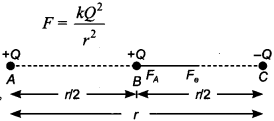
When a similar sphere B having charge +Q is kept at the mid-point of line joining A and C, then net force on B is

The direction is shown in figure.
6. A charge Q is divided into two parts of q and Q – q. If the coulomb repulsion between them when they are separated is to be maximum, the ratio of Q/q should be
(a) 2:1
(b) 1/2
(c) 4:1
(d) 1/4
Answer/Explanation
Answer: a
Explaination:
(a) Let separation between two parts be r, then
F = k.q(Q – q)/r² , For F to be maximum dF/dq = 0 then Q/q = 2/1 = 2 : 1
7. Four equal charges q are placed at the four comers A, B, C, D of a square of length a. The magnitude of the force on the charge at B will be
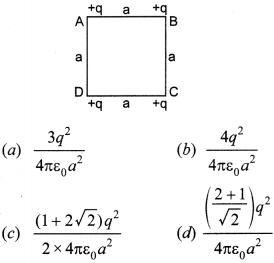
Answer/Explanation
Answer: c
Explaination:
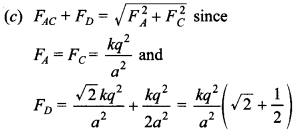

8. Dielectric constant for metal ______ .
Answer/Explanation
Answer:
Explaination:
Infinite [Dielectric constant K = \(\frac{\varepsilon}{\varepsilon_{0}}\)
Permittivity of metals (\(\E \)) is assumed to be very high.]
9. Two charges of equal magnitudes kept at a distance r exert a force F on each other. If the charges are halved and distance between them is doubled, then the new force acting on each charge is

Answer/Explanation
Answer: d
Explaination:
(d) F = \(\frac{k \cdot Q^{2}}{r^{2}}\). If Q is halved, r is doubled then F = \(\frac{1}{16}\) time
10. The electric field inside a spherical shell of uniform surface charge density is
(a) zero.
(b) constant, less than zero.
(c) directly proportional to the distance from the centre.
(d) none of the these
Answer/Explanation
Answer: a
Explaination:
(a) All charges reside on the outer surface of the shell so according to Gauss’s law, electric field inside the shell is zero.
11. A cylinder of radius R and length L is placed in a uniform electric field E parallel to the cylinder axis. The total flux for the surface of the cylinder is given by

Answer/Explanation
Answer: d
Explaination:
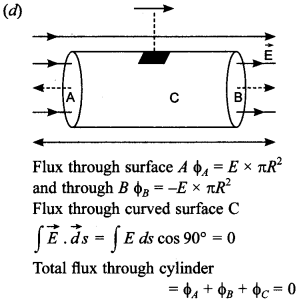
12. Electric field at a point varies as r° for
(a) an electric dipole
(b) a point charge
(c) a plane infinite sheet of charge
(d) a line charge of infinite length
Answer
Answer: c
13. An electric charge q is placed at the centre of a cube of side a. The electric flux on one of its faces will be

Answer/Explanation
Answer:
Explaination: (a) Using Gauss’s theorem
14. Total electric flux coming out of a unit positive charge kept in air is

Answer/Explanation
Answer: b
Explaination:
(b) Total flux coming out from the unit charge is
![]()
15. The electric field intensity due to an infinite cylinder of radius R and having charge q per unit length at a distance rir r(r > R) from its axis is
(a) directly proportional to r².
(b) directly proportional to r3.
(c) inversely proportional to r.
(d) inversely proportional to r².
Answer/Explanation
Answer: c
Explaination:
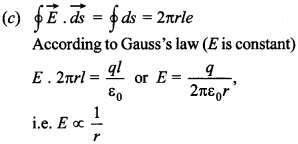
16. A point charge q is placed at a distance a/2 directly above the centre of a square of side a. The electric flux through the square is
![]()
Answer/Explanation
Answer: d
Explaination:
(d) An imaginary cube can be made by considering charge q at the centre and given square is one of its face. So flux through the given square (i.e. one face)

17. Which of the following graphs shows the variation of electric field E due to a hollow spherical conductor of radius R as a function of distance from the centre of the sphere?
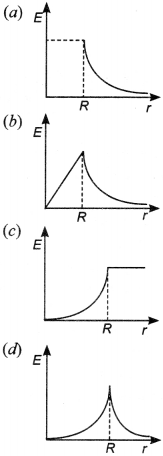
Answer/Explanation
Answer: a
Explaination:
(a) Electric field due to a hollow spherical conductor is governed by equations E = 0, for r < R …(i)
and \(E=Q / 4 \pi \varepsilon_{0} r^{2}\) for r ≥ R ….(ii)
i.e. inside the conductor, electric field will be zero and outside the conductor it will vary according to E oc 1/r².
18. The magnitude of electric field intensity E is such that, an electron placed in it would experience an electrical force equal to its weight is given by
(a) mge
(b) mg/e
(c) e/mg
(d) e²g/m²
Answer/Explanation
Answer: b
Explaination: (b) According to the question, eE = mg or E = mg/e
19. In Fig. (i) two positive charges q2 and q3 fixed along the y-axis, exert a net electric force in the +x direction on a charge q1 fixed along the x-axis. If a positive charge Q is added at (x, 0) in figure (ii), the force on q1 is [NCERT Exemplar]
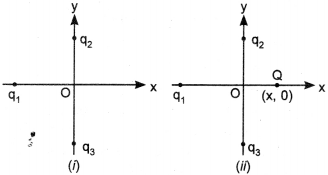
(a) shall increase along the positive x-axis.
(b) shall decrease along the positive x-axis.
(c) shall point along the negative x-axis.
(d) shall increase but the direction changes because of the intersection of Q with q2 and qy
Answer/Explanation
Answer: a
Explaination:
(a) The net electrostatic force on the charge q1 by the charges q2 and q3 is along the positive x-direction. Hence the nature of force between qu q2 and qx, q3 should be attractive. It means qx should be negative.
20. Which of the following statement is correct? The electric field at a point is [NCERT Exemplar]
(a) always continuous.
(b) continuous if there is a charge at that point.
(c) discontinuous only if there is a negative charge at that point.
(d) discontinuous if there is a charge at that point.
Answer/Explanation
Answer: d
Explaination:
(d) The electric field due to any charge will be continuous, if there is no other charge in the medium. It will be discontinuous if there is a charge at the point under consideration.
21. A point charge +q is placed at a distance d from an isolated conducting plane. The field at a point P on the other side of the plane is [NCERT Exemplar]
(a) directed perpendicular to the plane and away from the plane.
(b) directed perpendicular to the plane but towards the plane.
(c) directed radially away from the point charge.
(d) directed radially towards the point charge.
Answer/Explanation
Answer: a
Explaination:
(a) The electric field lines are away from positive charge and perpendicular to the surface. Hence the field at a point P on the other side of the plane is directed perpendicular to the plane and away from the plane.
22. Gauss’s law will be invalid if
(a) there is magnetic monopoles.
(b) the inverse square law is not exactly true.
(c) the velocity of light is not a universal constant.
(d) none of these.
Answer
Answer: b
23. SI unit of permittivity of free space is
(a) Farad
(b) Weber
(c) C2N-1 m-2
(d) C2N-1 m-2
Answer
Answer: c
24. A charge Q is placed at the centre of the line joining two point charges +q and +q as shown in the figure. The ratio of charges Q and q is
![]()
(a) 4
(b) 1/4
(c) -4
(d) -1/4
Answer
Answer: d
25. The force per unit charge is known as
(a) electric flux
(b) electric field
(c) electric potential
(d) electric current
Answer
Answer: b
26. Electric field lines provide information about
(a) field strength
(b) direction
(c) nature of charge
(d) all of these
Answer
Answer: d
27. Which of the following figures represent the electric field lines due to a single negative charge?

Answer
Answer: b
28. The SI unit of electric flux is
(a) N C-1 m-2
(b) N C m-2
(c) N C-2 m2
(d) N C-1 m2
Answer
Answer: d
29. The unit of electric dipole moment is
(a) newton
(b) coulomb
(c) farad
(d) debye
Answer
Answer: d
30. Consider a region inside which, there are various types of charges but the total charge is zero. At points outside the region
(a) the electric field is necessarily zero.
(b) the electric field is due to the dipole moment of the charge distribution only.
(c) the dominant electric field is inversely pro-portional to r3, for large r (distance from ori-gin).
(d) the work done to move a charged particle along a closed path, away from the region will not be zero.
Answer
Answer: c
31. The surface considered for Gauss’s law is called
(a) Closed surface
(b) Spherical surface
(c) Gaussian surface
(d) Plane surface
Answer
Answer: c
32. The total flux through the faces of the cube with side of length a if a charge q is placed at corner A of the cube is


Answer
Answer: a
33. Which of the following statements is not true about Gauss’s law?
(a) Gauss’s law is true for any closed surface.
(b) The term q on the right side side of Gauss’s law includes the sum of all charges enclosed by the surface.
(c) Gauss’s law is not much useful in calculating electrostatic field when the system has some symmetry.
(d) Gauss’s law is based on the inverse square dependence on distance contained in the coulomb’s law
Answer
Answer: c
34. Four charges are arranged at the comers of a square ABCD, as shown. The force on the charge kept at the centre O is

(a) zero
(b) along the diagonal AC
(c) along the diagonal BD
(d) perpendicular to side AB
Answer/Explanation
Answer: c
Explaination:
(c) Place a unit positive charge at O. Resultant force due to the charges placed at A and C is zero and resultant charge due to B and D is towards D along the diagonal BD.
35. One end of a copper wire is connected to a neutral pith ball and other end to a negatively charged plastic rod. What will be the charge acquired by a pith ball? [Chennai 2019]
Answer/Explanation
Answer:
Explaination: Negative charge.
36. Distinguish between an insulator (dielectric) and a conductor.
Answer/Explanation
Answer:
Explaination:
Dielectrics do not have free electrons, while conductors have free electrons. When some charge is transferred to a conductor, it readily gets distributed over the entire surface of the conductor, but on insulators, the charge stays at the same place.
37. Why does a nylon or plastic comb get electrified on combing or rubbing but a metal spoon does not?
Answer/Explanation
Answer:
Explaination:
The charge on a metal spoon discharges through our body to the ground as both are conductors. But when a nylon or plastic comb is rubbed, due to the friction its acquires a negative (-ve) charge, which stays on it as it is an insulator.
38. Two metallic spheres having same shape and size, but one of Cu and other of Al, are both placed in an identical electric field. In which metallic sphere will more charge be induced?
Answer/Explanation
Answer:
Explaination:
Same charge will be induced on both the spheres. As the dielectric constant K = oo for metals and the induced charge is given by q’ = \(=-q\left(1-\frac{1}{K}\right)\).
39. What causes the charging of an object?
Answer/Explanation
Answer:
Explaination:
When an object looses or gains electrons by friction/conduction/induction, then it is charged.
40. What does the additive nature of electric charge mean?
Answer/Explanation
Answer:
Explaination:
It means an electric charge is a scalar quantity and is added like algebraic numbers.
41. When does a charged ring behave as a point charge?
Answer/Explanation
Answer:
Explaination:
When the radius of ring is much smaller than the distance under consideration.
42. Two insulated charged copper spheres A and B of identical size have charges qA and qB respectively. A third sphere C of the same size but uncharged is brought in contact with the first and then in contact with the second and finally removed from both. What are the new charges on A and B1 [Chennai 2019, Foreign 2011]
Answer/Explanation
Answer:
Explaination:

43. What does q1 + q2 = 0 signify?
Answer/Explanation
Answer:
Explaination:
q1 + q2 = 0
⇒ q1 = – q2
∴ q1 and qq2 are the two charges of an electric dipole.
44. What is the cause of quantisation of electric charge?
Answer/Explanation
Answer:
Explaination:
The minimum charge that is stable, is charge of an electron. Since, electrons are transferred from one object to another, therefore, electric charge is said to be quantised.
45. What do you mean by conservative nature of the electric force?
Answer/Explanation
Answer:
Explaination:
The electric force is conservative in nature, because the work done by it in moving a charge is path independent.
46. If a body contains n1 electrons and n2 protons, then what will be the total amount of charge on the body?
Answer/Explanation
Answer:
Explaination:
Electric charge on n1 electrons = – n1e and electric charge on n2 protons = + n2e Therefore, the total charge = (n2 – n1)e.
47. What is the limitation of Coulomb’s law?
Answer/Explanation
Answer:
Explaination: It is applied only for point charges.
48. What does e(absolute permittivity) signify?
Answer/Explanation
Answer:
Explaination: It is a measure of the degree to which a medium can resist the movement of charges.
49. Define 1 coulomb (1 C) of electric charge.
Answer/Explanation
Answer:
Explaination:
One coulomb is that charge, when placed in vacuum at a distance of one metre from an equal and similar charge, would repel it with a force of 9 × 109 N.
50. Write two properties of an electrostatic force.
Answer/Explanation
Answer:
Explaination:
(a) It is conservative in nature.
(b) It depends on medium between the two charges.
51. Is the force acting between two point electric charges qx and q2 kept at some distance apart in air, attractive or repulsive when
(i) q1q2 > 0
(ii) q1q2 < 0?
Answer/Explanation
Answer:
Explaination:
(i) When q1q2 > 0, force is repulsive.
(ii) When q1q2 < 0, force is attractive.
52. The force on an electron kept in an electric field in a particular direction is F. What will be the magnitude and direction of the force experienced by a proton kept at the same point in the field? Mass of the proton is about 1836 times the mass of the electron.
![]()
Answer/Explanation
Answer:
Explaination: Same in magnitude and opposite in the direction as F = e.E
53. How does the coulomb force between two point charges depend upon the dielectric constant of the intervening medium?
Answer/Explanation
Answer:
Explaination:
![]()
Coulomb force is inversely proportional to the dielectric constant of the intervening medium.
54. State principle of superposition of forces.
Answer/Explanation
Answer:
Explaination:
Net force experienced by any charge in a group of charges is the vector sum of the forces acting on it due to rest of the charges of the group.
55. Define the dielectric constant of a medium. What is its unit? [Delhi 2011C]
Answer/Explanation
Answer:
Explaination:
Dielectric constant of a medium is defined as the ratio of the force between two charges placed a certain distance apart in vacuum to the force between the same two charges placed the same distance apart in the medium. It has no units.
56. Two equal balls having equal positive charge q coulombs are suspended by two insulating strings of equal length. What would be the effect on the force when a plastic sheet is inserted between the two? [AI 2014]
Answer/Explanation
Answer:
Explaination:
Electric force will reduce as plastic is an insulator. The force between the two charges will reduce by 1/K, where K is the dielectric constant of plastic.
57. Two electric field lines never cross each other. Why?
Answer/Explanation
Answer:
Explaination:
Two field lines can never cross each other. If they did, the field at the point of intersection will not have a unique direction, which is absurd.
58. Draw the electric field lines due to apoint charge
(i) Q > 0 and (ii) Q< 0.
Answer/Explanation
Answer:
Explaination:
(i) Q > 0 (ii) Q < 0
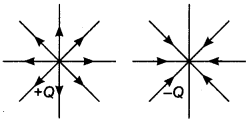
59. Why do the electric field lines not form any closed loops?
Answer/Explanation
Answer:
Explaination:
Because they originate from positive (+ve) charge and terminate at negative (-ve) charge.
60. Draw electric field lines for a system of two charges q1 and q2 such that
(i) q1q2 >0; q1>q2>0
(ii) q1 q2 <0; q1 > |-q2| < 0, |q1|> |-q2|
Answer/Explanation
Answer:
Explaination:

61. Draw the electric field lines if (i) a point charge + q is placed at the centre (ii) a point charge + q is placed at a distance R/2 from the centre.
Answer/Explanation
Answer:
Explaination:
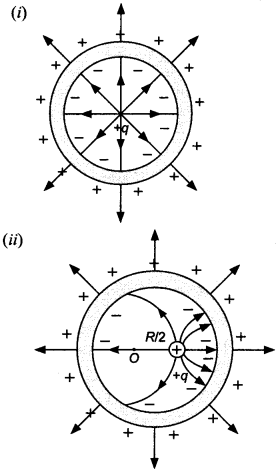
62. What is the physical significance of electric field?
Answer/Explanation
Answer:
Explaination:
From the knowledge of electic field intensity at any point, we can readily calculate the magnitude and the direction of force experienced by any .charge q0 placed at that point.
63. Define the term electric dipole moment. Is it a scalar or a vector quantity?
Answer/Explanation
Answer:
Explaination:
The product of the magnitude of one of the point charges constituting an electric dipole and the separation between them is termed as electric dipole moment.
It is a vector quantity.
64. What is an ideal (point) dipole?
Answer/Explanation
Answer:
Explaination:
An ideal dipole is the dipole whose size (2a) is vanishingly small, and the magnitude of electric charges constituting by it is very large, and the product, i.e. 2aq is finite.
65. What is the value of \(\left|\frac{E_{a x}}{E_{e q}}\right|\) for a short electric dipole?
Answer/Explanation
Answer:
Explaination:

66. Two point charges +q and -q are placed at a distance d apart. What are the points at which the resultant electric field is parallel to the line joining the two charges?
Answer/Explanation
Answer:
Explaination:
(i) At any point on axial line.
(ii) At any point on equitorial line of a dipole.
67. If F is the magnitude of force experienced by a unit charge placed at a distance of 1 cm from an infinitely large charged sheet, then what will be the force experienced by the same charge placed at a distance of 2 cm from the same sheet? [HOTS]
Answer/Explanation
Answer:
Explaination:
In case of sheet of charge, the electric field is constant. Hence, F – qE will be same irrespective of distance.
68. What is the direction of net force on electric dipole, placed in a non-uniform electric field?

Answer/Explanation
Answer:
Explaination:
Since, the electric field at the location of charge -q is more than that of field at charge +q. Therefore, the direction of net force will be in the direction opposite to the direction of \(\vec{E}\).
69. When does an electric dipole placed in a non-uniform electric field experience a zero torque but non-zero force?
Answer/Explanation
Answer:
Explaination: When the dipole axis is parallel to the direction of electric field.
70. Name the physical quantity whose SI unit is V.m. Is it a vector or a scalar quantity?
Answer/Explanation
Answer:
Explaination: The physical quantity is an electric flux. It is a scalar quantity.
71. Define the term electric flux. Write its SI unit. [Foreign 2017]
Answer/Explanation
Answer:
Explaination:
Electric flux through an area is the product of magnitude of area and the component of electric field vector normal to it.
![]()
72. What is a Gaussian surface?
Answer/Explanation
Answer:
Explaination:
A Gaussian surface is an imaginary closed surface in three dimensional space through with the flux of a vector field is calculated.
73. What is the use of a Gaussian surface?
Answer/Explanation
Answer:
Explaination:
A Gaussian surface is used to determine the electric field intensity around a point charge or charged body.
74. Why can a Gaussian surface not pass through any discrete charge?
Answer/Explanation
Answer:
Explaination:
Because the electric field due to a system of discrete charges is not defined at the location of any charge.
75. Two charges of magnitudes -2 Q and + Q are located at points (a, 0) and (4a, 0) respectively. What is the electric flux due to these charges through a sphere of radius 3a with its centre at the origin? [AI 2013]
Answer/Explanation
Answer:
Explaination:
According to the Gauss’s theorem, the total electric flux through any closed surface is equal to \(\frac{1}{\varepsilon_{0}}\) times, the total charge enclosed eo by the surface.
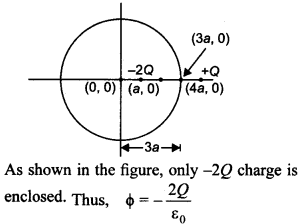
76. Does the charge given to a metallic sphere depend on whether it is hollow or solid? Give reason for your answer. [Delhi 2017]
Answer/Explanation
Answer:
Explaination: No. Electric charge resides on the outer surface only.
We hope the given Physics MCQs for Class 12 with Answers Chapter 1 Electric Charges and Fields will help you. If you have any query regarding CBSE Class 12 Physics Electric Charges and Fields MCQs Pdf, drop a comment below and we will get back to you at the earliest.